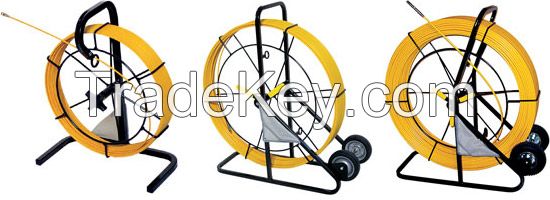详情
DCD offers one of the most comprehensive range of Duct Rodders
available
anywhere in the world - from the smallest 1/8" diameter Fish Tapes
to the
rugged 1/2" Duct Rodders.
The Rod
DCD rods are manufactured from state-of-the-art
materials formulated to offer the high performance &
durability demanded by our customers. The core of the rod
is manufactured by the pultrusion process. This involves
impregnating high strength continuous glass fiber filaments
with a liquefied resin. The fibers are drawn in to a heated
die where the resin matrix is cured, bonding the fibers
together and allowing mechanical loads to be transmitted
through the matrix and distributed amongst the fibers.
The resulting pultruded rod combines both the high stiffness
required to push the rod through long
distances of ducting, with the flexibility to handle tight bends
without damage. This inner core is then coated with a highly
durable, scratch resistant polypropylene sheath which protects
the core from mechanical damage.
The Frames
Frames are also a feature of the DCD systems. The four largest
sizes incorporate the new EZ-Tip™ feature; a larger
footprint
for stability; steel brake handles that will last forever; dual rod
out-feeding positions and wheels inside the frame width. The
two smallest sizes feature frames with the feedout built into
the handle. All frames can be laid down on either side. These are
just some of the design features that will make every unit
more usable and friendly for the end user.
Rod Selection
Which is the right rod diameter for any given application? The rod
selection is usually governed by several factors including:
- The size of ducting it is to be pushed through,
- The distance the rod is to be pushed,
- The number and tightness of bends in the ducting,
- If the ducting is already occupied by cable.
When being pushed through the duct, any rod will tend to form “sine
waves”, hitting the wall of the duct at certain
intervals. Each time the rod comes in contact with the wall of
the duct, it causes friction. The friction will build and
eventually prevent the rod from being pushed any further.
Small rod in large duct will make more frequent contact with the
ducting; the same rod in smaller duct will make less frequent
contact and therefore less friction so it can be pushed further.
Large rod in small ducting is
a good situation, but reduced flexibility of the rod may cause
increased friction in the tighter bends.
All of our Duct Rodders can be custome built to suit your needs.
For more informaiton, contact us, visit our website, or take a look
at our catalog. As prices very for size of Rod, please contact us
for the price of the rod you are interested in.
